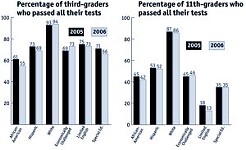Rebonding the Process
The players agree that that school bond process needs some serious attention
By Rachel Proctor May, Fri., Aug. 27, 2004
Vince Torres, another of the three CBAC chairs, says a related problem is that the district doesn't have a long-term plan in place for facilities and construction. "The whole process of developing bonds needs to be redone, and it needs to be redone now," he says. "We need to know what building changes we need to plan for – what will need to be replaced in five years. That way, the committee won't have to spend a year researching before they have something to show the public."
Torres believes the district should use a five-year bond cycle that he likens to car maintenance. Just as a car owner replaces his tires, oil, or timing belt at certain mileage intervals, the district should plan when it expects to fix or replace the roofs, HVAC systems, and other infrastructure that is brand-new today. That way, the bond committee of, say, 2015 will start out with a list of probable needs they can submit to the public for feedback and refinement at the beginning of the process, not the end. Torres says this kind of long-term planning should include greater devotion to preventive maintenance. "Because normal operations and maintenance budgets have been reduced over the years, the district has had more items needing to be replaced sooner," he said. In addition, putting off small repairs turns them into much more expensive ones, as when untreated minor roof leaks over time cause major structural damage.
Long-term planning could include attention to livability priorities, such as those identified by Envision Central Texas (i.e., less sprawl, more density). In the short term, the trustees could commit to working with other civic leaders to locate the undesignated school sites as centrally as possible – though that might require moving the district away somewhat from its declared commitment to neighborhood schools.
That's where planning now for the next bond package begins. Trustees say they can't justify denying schools to existing neighborhoods, but under a long-term plan, AISD could commit not to build in environmentally sensitive areas before the people are actually living there, rather than trying to punish them, in effect, after the fact. If refusing to build schools in environmentally sensitive areas is fair at all, the argument goes, it's certainly only fair if homebuyers are forewarned.
One might think, on the other hand, that three decades of Austin environmental wars would constitute fair warning. Official fingers always point elsewhere: AISD trustees blame the city and county, which grant the permits, lay the utilities, and build the roads, leaving the district (they say) no choice but to follow behind them with educational infrastructure. The trouble with this argument is that as long as the various regional entities – including the AISD board – continue to "respond" to sprawl by ratifying it after the fact, they can expect to keep right on responding.
Got something to say on the subject? Send a letter to the editor.








